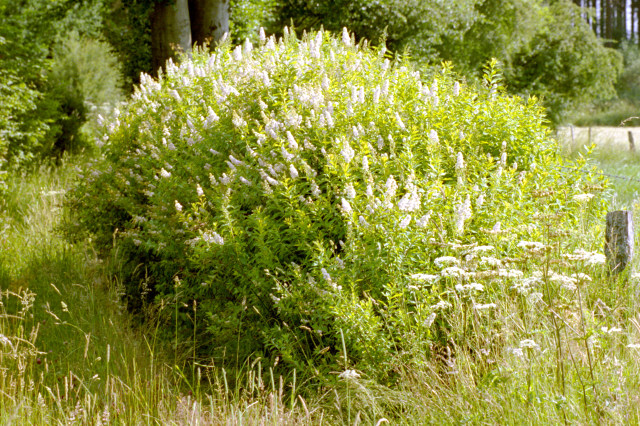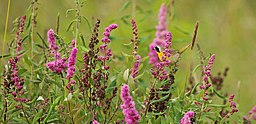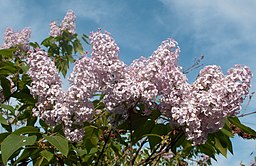 |
Northern red oak | Status LU: established. 1st record: LU <1873, ITW unkn. |
 |
Rout Eech | Status Eur.: established. 1st record: 1700s.1 |
 |
Chêne rouge d’Amérique | RA: ISEIA: C1. Harmonia+: 0,29. |
 |
Roteiche | Wikipedia: |
 |
Amerikaanse eik | Back to the list of neophytes |
Contents
Brief description
 Often planted in parks and woods, Quercus rubra L. grows on a variety of dry-mesic to mesic sites; it occurs in rich, mesic woods, on sandy plains, rock outcrops and at the outer edges of floodplains. It is intermediate in shade tolerance and is generally considered a midseral species, but its successional status is poorly known. It is generally unable to establish beneath its own canopy. In Lithuania, red oak seedlings have been reported to spread successfully over distances exceeding 300 metres from the parent trees. Its potential to colonise semi-natural habitats through long-distance dispersal is however uncertain in Belgian eco-climatic conditions (Branquart et al. 2012).
Often planted in parks and woods, Quercus rubra L. grows on a variety of dry-mesic to mesic sites; it occurs in rich, mesic woods, on sandy plains, rock outcrops and at the outer edges of floodplains. It is intermediate in shade tolerance and is generally considered a midseral species, but its successional status is poorly known. It is generally unable to establish beneath its own canopy. In Lithuania, red oak seedlings have been reported to spread successfully over distances exceeding 300 metres from the parent trees. Its potential to colonise semi-natural habitats through long-distance dispersal is however uncertain in Belgian eco-climatic conditions (Branquart et al. 2012).
Where planted, red oak recruitment rate is very high and young trees can form a dense understorey excluding ground vegetation and other tree species. Exclusion of ferns and grasses is favoured by the release of allelochemicals by leaves and roots. It is favoured over other tree species by heavy cutting because of its sprouting ability. Red oak is characterised by a species-poor phytophagous and saproxylic community in comparison to native oaks. Litter is hardly degraded and favours soil acidification. The species has also been reported to accelerate colonisation of open habitats near forest edges (Branquart et al. 2012).
Status and distribution in Luxembourg
Records of Quercus rubra L. in Luxembourg. Data source: Recorder-Lux, iNaturalist & GBIF, 2025-11-15.
Quercus rubra L. was first mentioned by Koltz (1873: 150) as grown in the forests, e.g. Johannisberg, Schäferei: Schönfels; this information is also listed by Krombach (1875: 407).
Since before 1850, when the tree nursery “de Planti” was founded by the municipal administration south of Hosingen, and until 1895, oak trees were grown here, which were used to create and replenish oak bark coppices. The quantity of acorns sown each year was 60 quintals. The gleaned acorns are not very abundant here, the seed was often bought abroad; this detail explains, incidentally, a curious fact: the presence of many American red oak trees in the coppices of the eastern part of the Oesling (R.F. 1951).2
The oldest herbarium specimen of Quercus rubra L. at the MNHNL was collected in July 1949 by Jos. Witry near Fischbach (Specimen № 50691, MNHNL 2000-).
Currently, 64 records of the northern red oak are accessible through the MNHNL-mdata portal (MNHNL, iNaturalist & GBIF 2019).
The northern red oak is not rare, planting is even in progress, also as a street tree (Welter et al. 2008: 54).
Grown for wood production, usually on acidic and relatively dry soils, more rarely for ornamental purposes in parks and along roads. Subspontaneous or naturalised here and there (Lambinon & Verloove 2012: 116).
Risk assessment
ISEIA protocol
C1 (1+1+1+1) (Ries et al. 2013: 18).
Harmonia+ protocol
Overall risk score 0,29 = (Overall Invasion score 0,63 x Overall Impact score 0,47) (Ries et al. 2020).
 Invasion
Invasion0,47

 Impact
Impact0,29

 Risk
RiskWorldwide distribution
Bibliography
- Branquart, E., S. Vanderhoeven, W. Van Landuyt, F. Van Rossum & F. Verloove, 2012. Harmonia database: Quercus rubra L. Harmonia version 1.2, Belgian Forum on Invasive Species. URL: http://ias.biodiversity.be [accessed on 2019-10-15]
- GBIF 2020. Quercus rubra J.F.Arnold in GBIF Secretariat (2019). GBIF Backbone Taxonomy. Checklist dataset https://doi.org/10.15468/39omei accessed via GBIF.org on 2020-03-02.
- Koltz, J.-P.-J., 1873. Prodrome de la flore du grand-duché de Luxembourg. Première partie. Plantes phanérogames. Imprimerie V. Buck, Luxembourg. 279 S.
- Krombach, J.-H.-G., 1875. Flore du grand-duché de Luxembourg. Plantes phanérogames. 564 p. Luxembourg, Imprimerie Joris.
- Lambinon J. & F. Verloove, 2012. Nouvelle flore de la Belgique, du grand-duché de Luxembourg, du Nord de la France et des régions voisines. Sixième édition. Avec la collaboration de L. Delvosalle, B. Toussaint, D. Geerinck, I. Hoste, F. Van Rossum, B. Cornier, R. Schumacker, A. Vanderpoorten et H. Vannerom. Jardin botanique national de Belgique, Meise. CXXXIX + 1195 pp. ISBN : 9789072619884.
- MNHNL, 2000-. Quercus rubra L. in Recorder-Lux, database on the natural heritage of the Grand Duchy of Luxembourg. Musée national d’histoire naturelle, Luxembourg. URL: https://mdata.mnhn.lu [Accessed 2019-10-15]
- MNHNL, iNaturalist & GBIF, 2019. Quercus rubra L. in MNHNL-mdata, online portal combining species observation from Recorder-Lux, iNaturalist and GBIF. National Museum of Natural History, Luxembourg. URL: https://mdata.mnhn.lu [Accessed 2019-10-15]
- R.F., 1951. Historique de la Pépinière domaniale de Hosingen. Service Information et presse, Bulletin d’information 5: 88. [PDF 183 KB]
- Ries, C. & Y. Krippel, 2021. First records of 56 invasive alien vascular plants in Luxembourg. Bulletin de la Société des naturalistes luxembourgeois 123: 115-127. [PDF 241 KB]
- Ries, C., Y. Krippel & M. Pfeiffenschneider, 2020. Risk assessment after the Harmonia+ protocol of invasive alien vascular plant species in Luxembourg. Bull. Soc. Nat. luxemb. 122: 197-205. [PDF 132 KB]
- Ries, C., Y. Krippel, M. Pfeiffenschneider & S. Schneider, 2013. Environmental impact assessment and black, watch and alert list classification after the ISEIA Protocol of non-native vascular plant species in Luxembourg. Bull. Soc. Nat. luxemb. 114: 15-21. [PDF 652 KB]
- Welter A., J.Turk & J. Trossen, 2008. Les arbres introduits au Luxembourg. Inventaire des essences arborescentes non indigènes de pleine terre présentes sur le territoire du Grand-Duché de Luxembourg. Ferrantia 53, Musée national d’histoire naturelle, Luxembourg, ISSN 1682-5519, 111 pp.
- Wikipedia contributors, 2021. Quercus rubra. In Wikipedia, The Free Encyclopedia. Retrieved 14:58, March 5, 2021, from https://en.wikipedia.org/w/index.php?title=Quercus_rubra&oldid=1002701429
Page content last updated on 2021-03-05. Last proofread by Caroline Grounds on 2019-11-20.
- Cf. Wikipedia contributors, 2021[↩]
- Original text in R.F. (1951): “La pépinière, que tout le monde à Hosingen appelle « de Planti », fut fondée, il y a plus d’un siècle [<1850], par l’administration communale. Jusqu’en 1895, on y cultivait du chêne qui servait à la création et au regarnissage des haies à éoorce. La quantité de glands qu’on semait chaque année s’élevait à 60 quintaux. Gomme les glandées sont peu abondantes chez nous, la semence était acheté très souvent à l’étranger; ce détail explique, soit dit entre parenthèse, un fait curieux: La présence de nombreux pieds de chêne rouge d’Amérique dans les taillis de la partie orientale de l’Oesling”.[↩]























